Easy Steps to Grow Beautiful Canna Lilies in Your Garden
Are you looking to add a touch of tropical paradise to your garden? The stunning Canna lily can transform your outdoor space into an exotic retreat. We’ll explore what you need to know about growing and maintaining these plants. Let’s look at basic care requirements to advanced cultivation techniques.
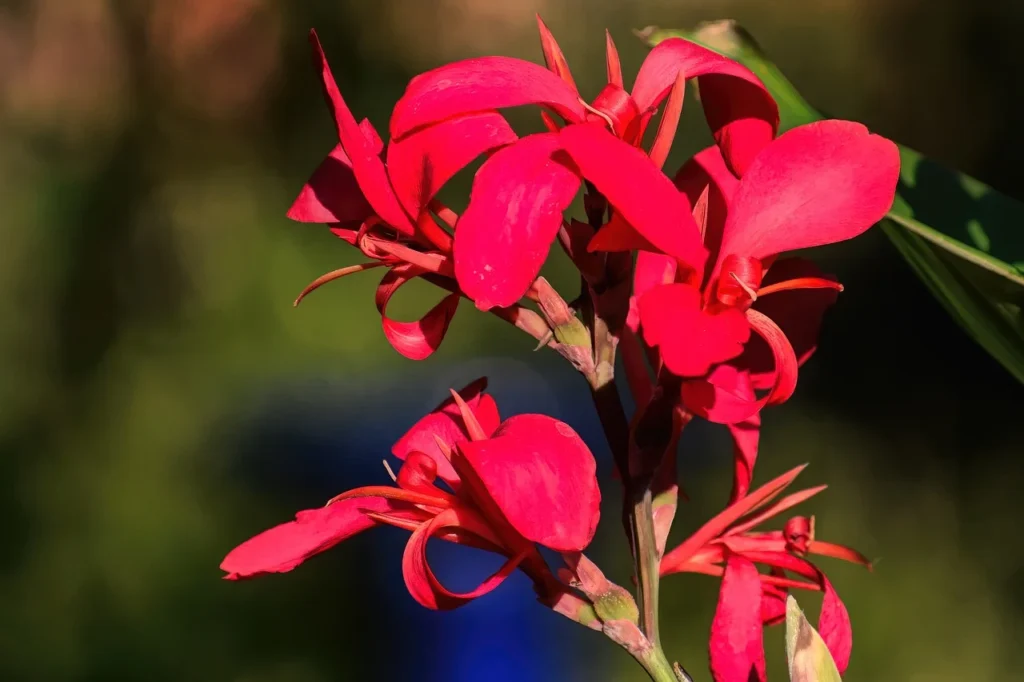
Introduction to Canna Lilies
Canna lilies (Canna indica) are among the most striking and rewarding plants. These beautiful flowering plants aren’t true lilies at all. They belong to their own family, Cannaceae. They are more closely related to gingers and bananas. Canna lilies have bold foliage and vibrant blooms. They have been captivating gardeners for centuries.
Canna lilies are native to tropical and subtropical regions of the Americas. These plants have spread worldwide, becoming a favorite among gardeners for their:
- Stunning tropical appearance
- Extended blooming period (often lasting from late spring until first frost)
- Low maintenance requirements
- Ability to thrive in various growing conditions
A Brief History
Canna lilies have a rich historical background that dates back centuries. Canna lilies were cultivated by indigenous peoples in the Americas for food and fiber. These plants made their way to Europe in the late 16th century. By the Victorian era, they had become a staple of elaborate garden designs.
Understanding Canna Lilies
Botanical Classification and Characteristics
- Height: Ranging from 1.5 to 8 feet tall, depending on the variety
- Foliage: Large, paddle-shaped leaves in shades of green, burgundy, or striped variations
- Flowers: Intricate blooms in various colors including:
- Red
- Orange
- Yellow
- Pink
- White
- Bi-colored varieties
Types of Canna Lilies
Canna lilies come in three main size categories:
- Dwarf Varieties
- Height: 1.5 to 3 feet
- Perfect for containers and small gardens
- Popular cultivars: ‘Tropical Rose’, ‘Picasso’, ‘Lucifer’
- Standard Varieties
- Height: 3 to 5 feet
- Ideal for garden beds and borders
- Notable cultivars: ‘King Humbert’, ‘The President’, ‘Wyoming’
- Giant Varieties
- Height: 5 to 8 feet
- Stunning backdrop plants
- Famous cultivars: ‘Musifolia’, ‘Russian Red’, ‘Bangkok’
Popular Cultivars and Their Features
Here are some of the most sought-after Canna lily varieties:
- ‘Tropicanna’:
- Height: 4-6 feet
- Striking striped foliage
- Orange flowers with yellow edges
- ‘Pretoria’ (also known as ‘Bengal Tiger’):
- Height: 4-5 feet
- Green and yellow striped leaves
- Orange blooms
- ‘Australia’:
- Height: 5-6 feet
- Deep burgundy foliage
- Bright red flowers
Benefits of Growing Canna Lilies
Canna lilies offer many advantages to gardeners:
- Visual Impact
- Create an instant tropical atmosphere
- Provide vertical interest
- Offer both impressive flowers and foliage
- Extended Beauty
- Bloom continuously for months
- Maintain attractive foliage throughout the growing season
- Can be overwintered for years of enjoyment
- Wildlife Benefits
- Attract hummingbirds
- Draw butterflies
- Support native pollinators
- Versatility
- Suitable for in-ground planting
- Excellent container specimens
- Can be grown in water gardens
- Effective as privacy screens
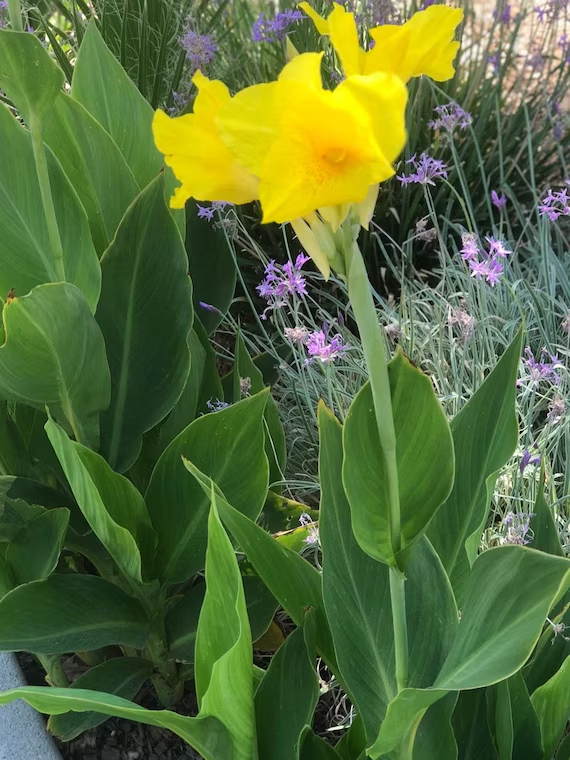
Growing Requirements for Canna Lilies
Light Requirements
Canna lilies are sun-loving plants that perform best with:
- Optimal Exposure: 6-8 hours of direct sunlight daily
- Minimum Requirement: At least 4-6 hours of direct sun
- Direction: South or west-facing locations are ideal
While Canna lilies can tolerate partial shade, you may notice:
- Reduced flowering in shadier spots
- Longer intervals between blooms
- Less vibrant foliage colors, especially in variegated varieties
Pro Tip: In hot climates, light afternoon shade can protect flowers from fading.
Soil Requirements
Ideal Soil Characteristics:
- Rich in organic matter
- Well-draining yet moisture-retentive
- pH level between 6.0 and 6.5
- Loamy texture
Soil Preparation Tips:
- Add compost or well-rotted manure before planting
- Incorporate organic matter to a depth of 12-15 inches
- Ensure proper drainage by breaking up compacted soil
- Consider raised beds in areas with heavy clay soil
Water Requirements
Proper watering is crucial for healthy Canna lily growth:
Watering Guidelines:
- Keep soil moist but not waterlogged
- Water when top 1-2 inches of soil feels dry
- Provide 1-1.5 inches of water per week
- Increase watering during the flowering period
Signs of Improper Watering:
Underwatering:
- Wilting leaves
- Crispy leaf edges
- Reduced flowering
- Stunted growth
Overwatering:
- Yellowing leaves
- Soft, mushy stems
- Root rot
- Fungal issues
Temperature and Climate Considerations
Understanding your climate is essential for Canna lily cultivation:
USDA Hardiness Zones:
- Grow as perennials in zones 8-11
- Treat as annuals in zones 2-7
- Overwinter rhizomes indoors in colder regions
Temperature Requirements:
- Optimal growing temperature: 70-75°F (21-24°C)
- Minimum temperature for growth: 55°F (13°C)
- Maximum temperature tolerance: 90°F (32°C)
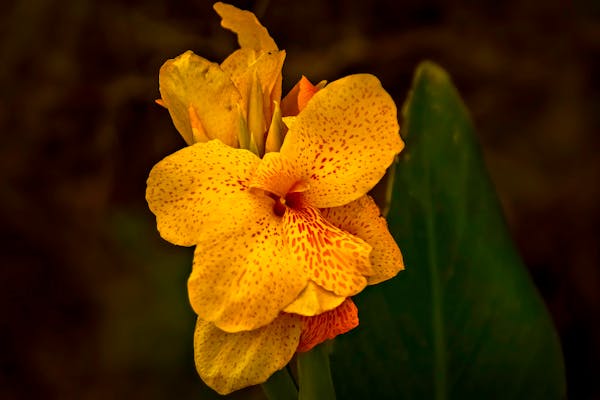
Planting Canna Lilies
Success with Canna lilies starts with proper planting techniques. What you need to know about getting these tropical beauties in your garden.
When to Plant
Timing is important for Canna lily growth:
Spring Planting (Most Common):
- After the last frost date
- Soil temperature above 55°F (13°C)
- Early morning or late afternoon
- Allow 3-4 months before the first fall frost
Regional Timing Guidelines:
- Southern zones: March-April
- Middle zones: April-May
- Northern zones: May-June
How to Plant
Follow these steps for optimal growth:
- Spacing Requirements:
- Dwarf varieties: 18-24 inches apart
- Standard varieties: 24-36 inches apart
- Giant varieties: 36-48 inches apart
- Planting Depth:
- Dig holes 4-6 inches deep
- Place rhizomes horizontally
- Cover with 2-3 inches of soil
- Eyes or growing points facing upward
- Group Planting Tips:
- Plant in odd-numbered groupings
- Create staggered arrangements
- Consider mature size when spacing
- Allow room for spread
Where to Plant
Canna lilies can be grown in various settings:
Garden Placement Options:
- Flower Beds:
- Back of borders (tall varieties)
- Middle of beds (medium varieties)
- Edge of paths (dwarf varieties)
- Tropical-themed gardens
- Container Growing:
- Minimum pot size: 5 gallons
- Good drainage essential
- Use high-quality potting mix
- Consider mobility for winter protection
- Water Gardens:
- Plant in submerged containers
- Water depth: 2-6 inches above soil level
- Use heavy clay soil to prevent floating
- Choose aquatic varieties
Landscape Design Ideas:
- Create privacy screens
- Define garden spaces
- Add height to borders
- Frame entrances or pathways
- Complement water features
Canna Lily Care Guide
Fertilizing Your Canna Lilies
Canna lilies are heavy feeders and need fertilization for growth and flowering:
Fertilizer Requirements:
- Type: High-phosphorus formula (5-10-5 or 10-10-10)
- Application Rate: Every 4-6 weeks during the growing season
- First Application: When shoots reach 6 inches tall
- Final Application: 6-8 weeks before first frost
Seasonal Feeding Schedule:
- Spring (Initial Growth):
- Light feeding when shoots emerge
- Balanced, water-soluble fertilizer
- Focus on root development
- Summer (Peak Growing Season):
- Monthly applications of high-phosphorus fertilizer
- Extra feeding for container plants
- Supplement with compost tea
- Fall (Pre-dormancy):
- Reduce feeding
- Switch to a lower nitrogen formula
- Stop fertilizing 6-8 weeks before frost
Common Fertilizing Mistakes to Avoid:
- Over-fertilizing (causes excessive foliage growth)
- Applying fertilizer to dry soil
- Using high-nitrogen formulas (reduces blooming)
- Inconsistent feeding schedule
Pruning and Maintenance
Regular maintenance keeps your Canna lilies looking their best:
Deadheading Techniques:
- Remove spent blooms at the base of the flower stalk
- Cut back to the next flower bud or leaf joint
- Use clean, sharp pruning shears
- Sanitize tools between plants
Foliage Maintenance:
- Remove yellowed or damaged leaves
- Cut back dead stalks to ground level
- Maintain air circulation between plants
- Clear debris from plant base
End-of-Season Tasks:
- Cut back all foliage to 6 inches above ground
- Remove and dispose of all plant debris
- Clean area around plants
- Apply winter mulch in zones 8-10
Pest Management
Canna lilies can attract various pests. Here’s how to identify and control them:
Common Pests:
- Japanese Beetles:
- Signs: Skeletonized leaves, holes in flowers
- Control:
- Hand-picking early morning
- Neem oil applications
- Beneficial nematodes in soil
- Physical barriers
- Spider Mites:
- Signs: Fine webbing, stippled leaves
- Control:
- Strong water spray
- Insecticidal soap
- Predatory mites
- Increased humidity
- Slugs and Snails:
- Signs: Irregular holes in leaves, slime trails
- Control:
- Copper tape barriers
- Diatomaceous earth
- Beer traps
- Iron phosphate baits
Organic Prevention Methods:
- Companion planting with pest-repelling herbs
- Regular inspection of plants
- Maintaining healthy soil
- Encouraging beneficial insects
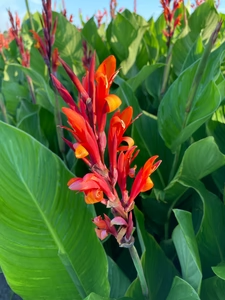
Disease Prevention and Treatment
Understanding common diseases helps maintain healthy Canna lilies:
Major Diseases:
- Canna Rust:
- Symptoms:
- Orange-brown pustules on leaves
- Premature leaf drop
- Reduced vigor
- Prevention:
- Good air circulation
- Avoid overhead watering
- Remove infected leaves
- Fungicidal treatments
- Symptoms:
- Bacterial Blight:
- Symptoms:
- Water-soaked leaf spots
- Brown leaf edges
- Wilting
- Prevention:
- Clean tools
- Remove infected plants
- Avoid overcrowding
- Proper watering practices
- Symptoms:
- Root Rot:
- Symptoms:
- Yellowing leaves
- Soft, brown roots
- Plant collapse
- Prevention:
- Well-draining soil
- Proper planting depth
- Avoid overwatering
- Regular soil checks
- Symptoms:
Virus Problems:
- Canna Yellow Mottle Virus
- Bean Yellow Mosaic Virus
- Cucumber Mosaic Virus
Important Note: Viral diseases are incurable. Remove and destroy infected plants to prevent spread.
Disease Prevention Best Practices:
- Buy disease-free rhizomes
- Maintain proper spacing
- Water at soil level
- Clean tools between plants
- Monitor for early signs
- Remove plant debris promptly
Propagation Methods for Canna Lilies
Learn how to multiply your Canna lily collection through propagation techniques.
Division of Rhizomes
Division is the most reliable method for propagating Canna lilies:
When to Divide:
- Every 3-4 years
- When clumps become overcrowded
- Early spring before new growth
- After fall frost in warmer zones
Step-by-Step Division Process:
- Lift the Rhizome Clump:
- Dig 6 inches away from stems
- Lift entire clump carefully
- Shake off excess soil
- Rinse if needed
- Inspect and Clean:
- Remove dead or rotted sections
- Cut away damaged areas
- Look for healthy eyes (growth points)
- Clean with diluted bleach solution (1:10)
- Divide the Rhizomes:
- Cut into 4-6 inch sections
- Ensure each piece has 2-3 eyes
- Use a sterilized sharp knife
- Let cuts callus for 24 hours
- Prepare for Replanting:
- Dust cuts with fungicide
- Store in dry peat moss
- Label varieties
- Keep at 50-60°F until planting
Growing from Seed
Seed Collection:
- Allow pods to mature on the plant
- Harvest when pods turn brown
- Clean seeds
- Dry completely before storage
Seed Storage:
- Keep in paper envelopes
- Store in a cool, dry place
- Label with variety and date
- Viable for 1-2 years
Germination Process:
- Preparation:
- Nick seed coat
- Soak in warm water for 24-48 hours
- Prepare sterile seed starting mix
- Maintain temperature at 70-75°F
- Planting:
- Sow 1/4 inch deep
- Space 2 inches apart
- Keep soil moist
- Provide bottom heat
- Seedling Care:
- Germination in 10-14 days
- Provide bright, indirect light
- Maintain consistent moisture
- Feed with diluted fertilizer
Winter Care and Storage
Proper winter care ensures the survival of Canna lilies in colder regions:
Lifting Rhizomes
Timing:
- After the first frost
- Before ground freezes
- When foliage yellows
- Clear, dry days preferred
Process:
- Cut stems to 6 inches
- Dig around the clump
- Lift the entire root ball
- Remove excess soil
Cleaning and Curing
Steps for Processing:
- Initial Cleaning:
- Rinse soil from rhizomes
- Remove dead roots
- Cut away damaged areas
- Let dry for 24 hours
- Disease Prevention:
- Inspect for rot or damage
- Treat with fungicide
- Ensure good air circulation
- Remove all foliage
Storage Conditions
Optimal Storage Requirements:
- Temperature: 40-50°F (4-10°C)
- Humidity: 50-60%
- Darkness preferred
- Good air circulation essential
Storage Methods:
- Peat Moss Method:
- Layer rhizomes in damp peat
- Store in ventilated containers
- Check monthly for problems
- Remove any rotting pieces
- Paper Bag Method:
- Wrap in newspaper
- Place in paper bags
- Store in a cool basement
- Check for moisture
- Plastic Container Method:
- Use containers with ventilation holes
- Layer with dry vermiculite
- Don’t stack rhizomes
- Check for condensation
Common Problems and Solutions
Growth Issues
Poor Blooming:
- Causes:
- Insufficient light
- Improper fertilization
- Overcrowding
- Poor soil conditions
- Solutions:
- Move to sunnier spot
- Adjust feeding schedule
- Division of clumps
- Soil amendment
Leaf Problems:
- Symptoms:
- Yellowing
- Browning edges
- Spotting
- Curling
- Remedies:
- Check water levels
- Adjust fertilization
- Treat for pests
- Improve air circulation
Environmental Stress
Heat Stress:
- Signs:
- Wilting despite moisture
- Leaf scorch
- Reduced flowering
- Stunted growth
- Management:
- Provide afternoon shade
- Increase watering frequency
- Mulch to keep moisture
- Mist foliage in extreme heat
Cold Damage:
- Symptoms:
- Blackened foliage
- Soft, mushy stems
- Die-back
- Rotting rhizomes
- Prevention:
- Watch weather forecasts
- Protect with mulch
- Lift rhizomes before frost
- Proper winter storage
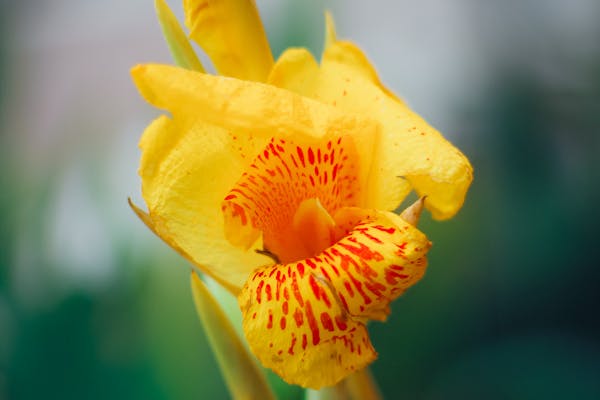
Seasonal Care Calendar for Canna Lilies
Follow this month-by-month guide to ensure your Canna lilies thrive throughout the year.
Spring Care (March-May)
Early Spring Tasks:
- March:
- Plan garden layout
- Order new rhizomes
- Prepare soil
- Start indoor storage inspection
- April:
- Begin hardening off stored rhizomes
- Prepare planting beds
- Apply pre-planting fertilizer
- Check soil temperature
- May:
- Plant rhizomes outdoors
- Apply slow-release fertilizer
- Begin watering routine
- Check for early pests
Spring Care Tips:
- Wait until the soil reaches 55°F
- Protect from late frosts
- Space for air circulation
- Begin pest monitoring schedule
Summer Care (June-August)
Peak Growing Season Tasks:
- June:
- Establish a regular watering schedule
- Begin monthly fertilization
- Watch for pest issues
- Start deadheading routine
- July:
- Continue deadheading
- Maintain moisture levels
- Check for spider mites
- Support tall varieties if needed
- August:
- Continue regular maintenance
- Check for Japanese beetles
- Prepare for potential division
- Document variety performance
Summer Maintenance Checklist:
- Water during dry spells
- Remove spent blooms weekly
- Check for signs of disease
- Apply supplemental fertilizer as needed
Fall Care (September-November)
End-of-Season Tasks:
- September:
- Reduce fertilization
- Continue deadheading
- Plan for winter storage
- Take photos for records
- October:
- Watch for frost warnings
- Begin reducing water
- Clean garden tools
- Prepare storage materials
- November:
- Lift rhizomes after frost
- Clean and process for storage
- Clear garden debris
- Apply winter mulch to in-ground plants
Winter Care (December-February)
Storage Period Tasks:
- December:
- Watch storage conditions
- Check for rot or damage
- Remove affected rhizomes
- Maintain temperature control
- January:
- Plan next season’s garden
- Order new varieties
- Check stored rhizomes
- Clean and sharpen tools
- February:
- Begin preparations for spring
- Check the viability of stored rhizomes
- Start indoor pre-sprouting
- Buy supplies for the new season
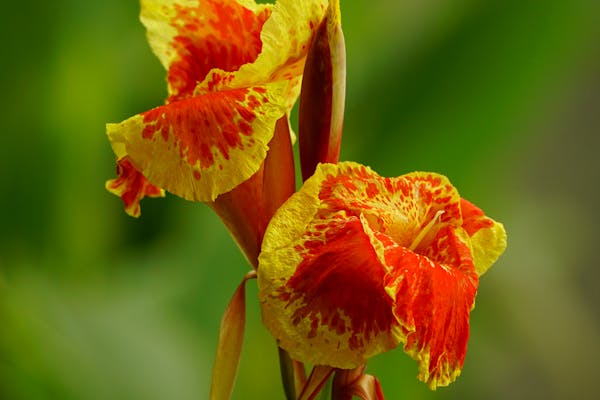
Frequently Asked Questions About Canna Lilies
Growth and Planting
Q: Why aren’t my Canna lilies blooming? A: Poor blooming usually results from:
- Insufficient sunlight
- Improper fertilization
- Overcrowded rhizomes
- Poor soil conditions Solution: Ensure plants receive 6-8 hours of sun daily. Fertilize the plants monthly, and divide crowded clumps.
Q: Can I grow Canna lilies in containers? A: Yes! Use these guidelines:
- Minimum 5-gallon container
- Rich, well-draining potting mix
- Regular fertilization
- Consistent moisture
Q: How long do Canna lilies bloom? A: Canna lilies can bloom from late spring until frost, 3-4 months in most regions.
Maintenance and Care
Q: Should I mulch my Canna lilies? A: Yes, mulching provides several benefits:
- Moisture retention
- Weed suppression
- Temperature regulation
- Improved appearance Apply 2-3 inches of organic mulch, keeping it away from stems.
Q: How often should I divide my Canna lilies? A: Divide Canna lilies every 3-4 years or when:
- Flowering decreases
- The center of the clump dies out
- Plants become overcrowded
- Rhizomes push up from soil
Winter Care
Q: Can I leave Canna lilies in the ground over winter? A: Depends on your climate:
- Zones 8-11: Yes, with proper mulching
- Zones 2-7: No, lift and store rhizomes
- Microclimate considerations apply
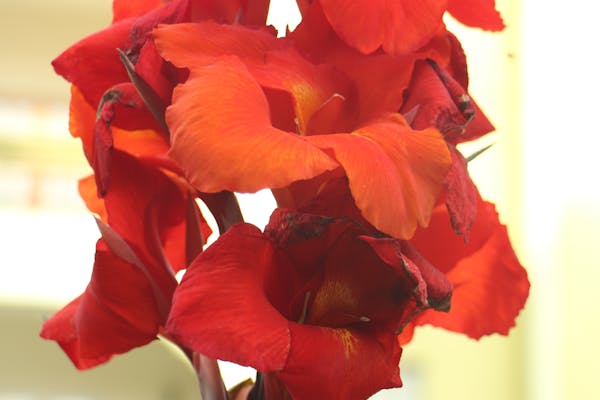
Conclusion
Growing Canna lilies can transform your garden into a tropical paradise. Success depends on understanding their basic needs and following a consistent care routine. Remember these key points:
Essential Care Requirements:
- Full sun exposure
- A rich, well-draining soil
- Regular watering
- Monthly fertilization
- Proper winter protection
Benefits of Growing Canna Lilies:
- Long blooming period
- Dramatic foliage
- Versatile garden use
- Wildlife attraction
- Easy propagation